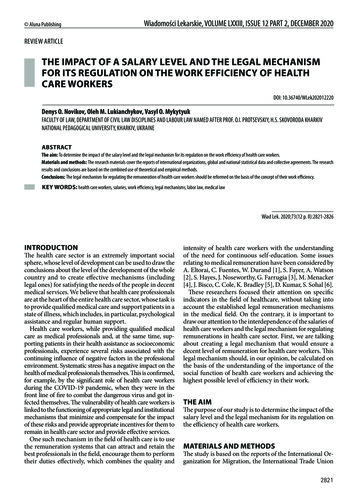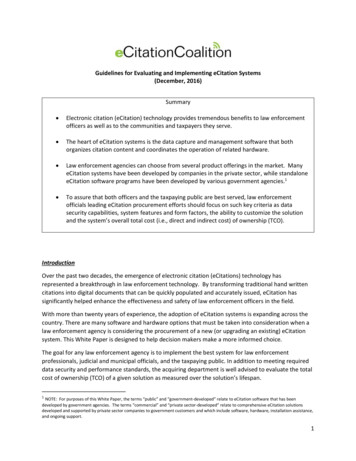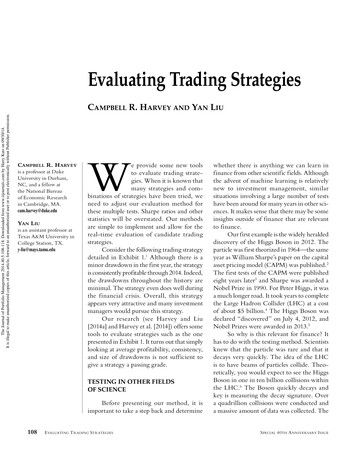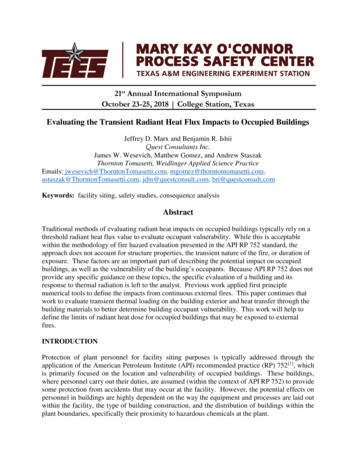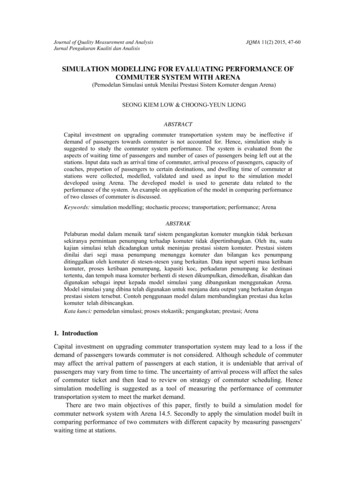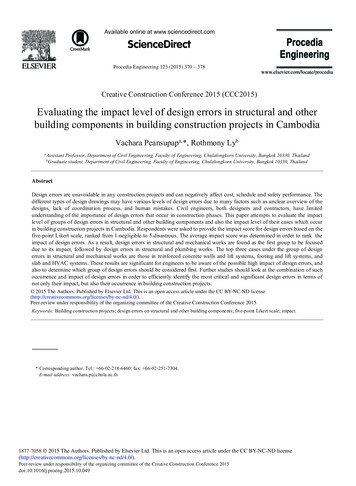
Transcription
Available online at www.sciencedirect.comScienceDirectProcedia Engineering 123 (2015) 370 – 378Creative Construction Conference 2015 (CCC2015)Evaluating the impact level of design errors in structural and otherbuilding components in building construction projects in CambodiaVachara Peansupapa,*, Rothmony LybaAssistant Professor, Department of Civil Engineering, Faculty of Engineering, Chulalongkorn University, Bangkok 10330, ThailandbGraduate student, Department of Civil Engineering, Faculty of Engineering, Chulalongkorn University, Bangkok 10330, ThailandAbstractDesign errors are unavoidable in any construction projects and can negatively affect cost, schedule and safety performance. Thedifferent types of design drawings may have various levels of design errors due to many factors such as unclear overview of thedesigns, lack of coordination process, and human mistakes. Civil engineers, both designers and contractors, have limitedunderstanding of the importance of design errors that occur in construction phases. This paper attempts to evaluate the impactlevel of groups of design errors in structural and other building components and also the impact level of their cases which occurin building construction projects in Cambodia. Respondents were asked to provide the impact score for design errors based on thefive-point Likert scale, ranked from 1-negligible to 5-disastrous. The average impact score was determined in order to rank theimpact of design errors. As a result, design errors in structural and mechanical works are found as the first group to be focuseddue to its impact, followed by design errors in structural and plumbing works. The top three cases under the group of designerrors in structural and mechanical works are those in reinforced concrete walls and lift systems, footing and lift systems, andslab and HVAC systems. These results are significant for engineers to be aware of the possible high impact of design errors, andalso to determine which group of design errors should be considered first. Further studies should look at the combination of suchoccurrence and impact of design errors in order to efficiently identify the most critical and significant design errors in terms ofnot only their impact, but also their occurrence in building construction projects. 20152015TheTheAuthors.Authors.PublishedElsevier Publishedby byElsevierLtd.Ltd.This is an open access article under the CC BY-NC-ND nd/4.0/).Peer-review under responsibility of the organizing committee of the Creative Construction Conference 2015.Peer-review under responsibility of the organizing committee of the Creative Construction Conference 2015Keywords: Building construction projects; design errors on structural and other building components; five-point Likert scale; impact.* Corresponding author. Tel.: 66-02-218-6460; fax: 66-02-251-7304.E-mail address: vachara.p@chula.ac.th1877-7058 2015 The Authors. Published by Elsevier Ltd. This is an open access article under the CC BY-NC-ND nd/4.0/).Peer-review under responsibility of the organizing committee of the Creative Construction Conference 2015doi:10.1016/j.proeng.2015.10.049
Vachara Peansupap and Rothmony Ly / Procedia Engineering 123 (2015) 370 – 3783711. IntroductionDesign errors are an inevitable and important issue which have negative impact on project management efficiencyand effectiveness [1]. They are the important contributors to reworks, cost overruns, schedule delays, and unsafeenvironments which affect project performance [1, 2]. In practice, owner, designer, contractor, and otherstakeholders have different interests in the design [3]. These various interests certainly lead to design errors whichcan arise at any time [4]. The occurrence of these errors can increase many difficulties in construction management.These difficulties can lead to between 80% and 90% of the failures occurring in civil engineering projects [5]. Theycan also incur more cost that adds a project’s value around 14.2% [6-8]. Design errors are a serious threat toconstruction projects [5, 9-11]. Besides, the use of technology is limited in construction development in Cambodiabecause of inadequate human resources and limited education system. This is a reason that the occurrence of designerrors cannot be effectively controlled and can greatly affect the construction process. Design errors are thus verysignificant and should be carefully managed to ensure the success of construction projects and to minimisedifficulties in project performance. To create an effective strategy to manage design errors, it is important torecognise the level of their impact. The impact of design errors has been already assessed in previous studies;however, only schedule delays have been studied by developing a model of seven sub-modules, such as genericwork execution, effort, precedence relationship, productivity, resources, progress measurement, and managerialcontrol [4]. The impact of design errors in structural and other building components has not been yet studied in detailand well-understood. Design errors in different building components may have different levels of impact. Therefore,the purpose of this study is to evaluate the impact level of design errors in structural and other building componentsin building construction projects. This study can help practitioners to clearly understand the most affected groups ofdesign errors and the most significant cases under each group. It will help them to learn the kinds of design errorsthat disastrously affect the projects.2. Design errors in building construction projectsDesign errors are inevitable in the construction industry. Many researchers consider design errors as the mostcritical problems and have defined the term ‘design errors’ in various ways. Reichart [12] claims that design errorsare unavoidable failures occurring when information is incorrectly applied or used, or the pertinent information isnot accessible. ’Design errors’ refers to the failures of humans to design tasks within time limits and accuracy [13].Owing to the required level of accuracy and time constraints, common human errors can lead to design errors. Theseproblems can influence the quality of both design and construction. Deviation from actual values, inadequateprecision and inconsistencies in measurement are also considered as design errors [14]. In this article, ‘design errors’refers to design mistakes, design omissions, and design conflicts. Design mistakes are the human errors that areoccur naturally and are unavoidable. An inexperienced designer may apply the design information incorrectly. Thesemistakes can be lapses (memory failures) or slips (when failure arises even if knowledge is correct) [5]. Designomission occurs if any part of a system has been forgotten in the design [15]. Design conflicts are the overlappingitems that cannot be constructed at the same time.3. Groups of design errors between structural and other building componentsDetailed building design process consists of five disciplines: architectural design, civil design, structural design,mechanical design, and electrical design [16]. Mechanical, electrical, and plumbing systems (MEP systems) havecaused many problems related to limited space for MEP system installation [17]. This suggests that it is necessary tostudy about design errors associated with MEP systems. Design errors in structural and plumbing works are alsoincluded in this study, while civil work is excluded because it is not about the internal structure of the building.According to the detailed building design process and the necessity of MEP systems, design errors betweenstructural and other building components involve five different groups, such as design errors between structure andarchitecture (Group A), design errors between structure and structure (Group B), design errors between structure andmechanical works (Group C), design errors between structure and electrical works (Group D), and design errors
372Vachara Peansupap and Rothmony Ly / Procedia Engineering 123 (2015) 370 – 378between structure and plumbing systems (Group E). Each building component also has sub-elements which arestudied in this research. The sub-elements of architecture, structure, and mechanical works are based on the bills ofquantities (BOQs) for reinforced concrete building projects in Cambodia. For electrical and plumbing works, thesub-elements are extracted from the article by Tatum and Thomas [17]. For instance, the sub-elements of structureare retaining walls, footing, beams, columns, slabs, stairs, and reinforced concrete walls. All sub-elements for eachbuilding component are presented in Figure 1.Architecture (Group A) Wall finish, floor finish, ceiling works, staircase finish (stair handrail etc.),door/window, sanitary ware (materials in bathroom or kitchen)Structure (Group B) Retaining wall, footing, beam, column, slab, stair, reinforced concrete wallBuildingcomponentsMechanical works (Group C) HVAC systems (heating, ventilating, and air conditioning), lift systemsElectrical works (Group D) Electrical system and telephone/datacom systemPlumbing works (Group E) Water supply and distribution system, sanitary drainage and disposal system,storm drainage system, fire protection system, and fuel and gas piping systemFigure 1. Building components and their sub-elementsPrevious studies have not mentioned about the five groups of design errors. The impact of design errors has beenassessed only in a specific area of schedule delays [4]. In this research, the impact of design errors in each group isevaluated. Specifically, design errors in a particular structural element and another sub-element are discussed andanalysed in details since different elements may have different level of impact level on the project. Therefore, thispaper has two main objectives: First objective is to identify the impact level of each group of design errors and thesecond objective is to explore the impact level of each case of design errors under its group.4. Research methodologyThis research is a case study for which the data was collected in Cambodia. It uses an exploratory approach thatexplores the design errors with the most impact on project performance. A quantitative survey questionnaire wasused to identify the impact level of design errors. The methodology of this research is divided into three main steps:survey questionnaire design, data collection, and data analysis. Average formulas and the grading method wereapplied for data analysis. Figure 2 illustrates the subsequent process of this study.
373Vachara Peansupap and Rothmony Ly / Procedia Engineering 123 (2015) 370 – 378Survey questionnairedesignData CollectionDetailed buildingdesign processAverage formula(Equation 1)Impact score of eachcase of design errorsResultsImpact level of each group ofdesign errorsClassification ofimpact score122 possible cases ofdesign errors areidentifiedAverage formula(Equation 2)Impact level of each case ofdesign errorsInterview154 cases of designerrors are listedSurvey questionnaireFive-point Likert scale5 groups of designerrorsData AnalysisFigure 2. Research methodology4.1. Survey questionnaire design154 cases of design errors in structural and other building components were listed from the sub-elements of eachsystem and used to develop a survey questionnaire for data collection. A five-point Likert scale was applied toevaluate the impact score for each case of design errors. This scale consists of five rating scores, ranked from 1 to 5,where 1 negligible, 2 marginal, 3 substantial, 4 severe, and 5 disastrous. ‘Negligible’ refers to unimportantdesign errors which do not affect the project. ‘Marginal’ means design revision is needed; but time, cost andconstruction process remain unaffected. ‘Substantial’ is design error that needs design revision and time for solving;it does not incur more cost or obstruct construction activities. ‘Severe’ means that design error requires designrevision, time, and cost; yet this error does not delay the construction process. ‘Disastrous’ is design error that needsto be revised and solved by spending more cost and time. The related works cannot be continued due to this error. Inthis study, two criteria were used to choose the samples. The questionnaire was a project-based survey whichrequired the respondents to provide only the situations they have faced in an already complete reinforced concretebuilding project. They also had to be involved in the whole construction process of that project. These criteria are tomake sure that the respondents can provide whole information of design errors in the project.4.2. Data collectionEleven Cambodian civil engineers were interviewed via a survey questionnaire to collect information about theimpact of design errors which occur in building projects in Phnom Penh, the capital city of Cambodia. Since this is aproject-based survey, only eleven building projects could be accessed during data collection. All informationprovided by the respondents was treated as confidential and not used for other purposes. The target respondents haveat least two years’ experience on construction works with reinforced concrete building projects and hold at least aBachelor’s Degree in Civil Engineering. Under all five groups of design errors, only 122 of the 154 cases werefound to be valid and likely to occur based on the respondents’ experience in their individual project. The othercases did not occur in any sampling projects, and thus those cases are negligible and not included in this study.
374Vachara Peansupap and Rothmony Ly / Procedia Engineering 123 (2015) 370 – 3784.3. Average formulasIn this study, averaging formulas were applied in order to determine the average impact scores of design errors.According to [18], two particular average formulas were formulated a
These difficulties can lead to between 80% and 90% of the failures occurring in civil engineering projects [5]. They can also incur more cost that addsa project’s value around 14.2% [6-8]. Design errors area serious threat to construction projects [5, 9-11]. Besides, the use of technology is limited in construction development in Cambodia


